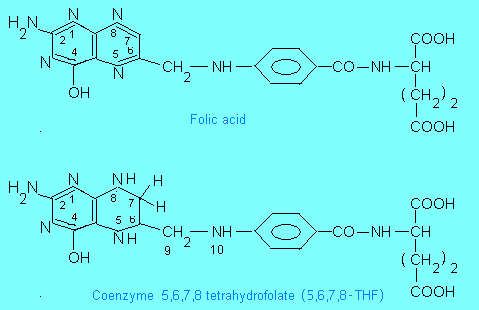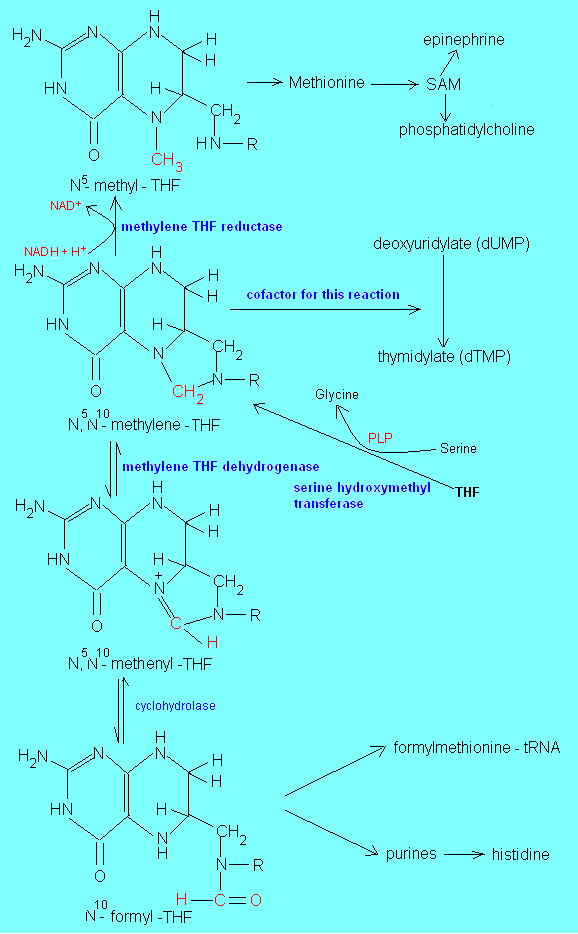|
Folic acid

- Folic acid is seldom found as such in the human body or in foods. On the other hand, vitamin supplements contain mostly folic acid. So, to become biologically active the folic acid must be enzymatically reduced.
This reaction is catalyzed by dihydrofolate reductase, which requires NADPH as coenzyme. Some of the active chemical forms are: 5,6,7,8 tetrahydrofolate (THF), 5,10-methenyl THF, 10-formyl THF. Folate coenzymes are involved in one-carbon unit (formyl and methyl groups) transfer reactions in the metabolism of nucleic acids (synthesis of dTMP) and certain amino acids (methionine, glycine, serine) as well as choline.
The C1 units are covalently attached to the N(5), N(10) or both positions of THF.
They are generated through the conversion of serine to glycine (a reaction catalyzed by the
hydroxymethyl transferase) and the cleavage of glycine (catalyzed by glycine synthase also called glycine cleavage enzyme). Histidine can also
contribute C1 units with the formation of N5-formimino-THF.
The various forms of C1 units bound to THF easily interconvert between each
other. The interconversion and the fate of the C1 units in the THF pool is shown below.

- Essential for the synthesis of nucleic acids and thus critical to cellular division. Poor dietary habits and addiction to high alcohol consumption can lead to folate deficiency. Low cellular levels of N5, N10-methylenetetrahydrofolate (the cofactor for thymidylate synthase) decreases the synthesis of dTMP. As a result there is an increased chance for the DNA polymerase-mediated dUTP misincorporation into DNA because of a higher dUMP/dTMP ratio (1). This can happen when the activity of methylene THF reductase is too high and as a result there is insufficient N5, N10-methylenetetrahydrofolate cofactor for the synthesis of dTMP. Two opposing nicks can lead to double strand breaks in the DNA molecule. Repeated chromosome breaks will result in impaired cell function and disease. Such DNA lessions can lead to cell cycle arrest in the S-phase of rapidly proliferating cells such as the hematopoietic cells. Folate deficiency symptoms mimics those observed in vitamin B12 deficiency.
- Critical to the development of the nervous system of the fetus. Deficiency of folic acid during pregnancy has been linked to neural tube defects like spina bifida, a birth defect.
- One of the folate coenzymes, i.e. N5-methyl THF is involved in the conversion of homocysteine to methionine. Increased levels of plasma homocysteine have been associated with greater risk for developing heart disease.
- Cell culture experiments using a mouse fibroblast cell line suggested that folic acid may act
as an iron modulatory factor by altering thr Fe2+/Fe3+ ratio through Fe2+ oxidation. A folate-derived compound, 6-formyl pterin was found to possess an even greater iron-oxidizing power (2).
- Folate and vitamin B12 deficiency and elevated plasma homocysteine are significantly correlated with increased micronucleus formation and reduced telomere length, respectively (3).
- Interactions: Folate coenzymes work together with vitamin B12, vitamin B6
and choline (a component of the cell membrane and other intracellular structures). Alcohol, some chemotherapy drugs, barbiturates, anticonvulsants and sulfonamides (sulfa drugs) interfere with folic acid synthesis, absorption and function. Since the sulfonamides are structural analogs of the p-aminobenzoic acid (a constituent of THF) they competitively inhibit the biosynthesis of THF in procaryotes. Based on this property the sulfa drugs are widely used as antibacterial agents.
- Health benefits: Supplementation is useful in conditions such as acne, anemia, atherosclerosis, constipation, depression, fatigue, hepatitis, osteoporosis, gum disease, seborrheic dermatitis.
- Best food sources: Brewer's yeast, green leafy vegetables, whole grains.
References
1. Blount, B.C. et al. (1997) Proc.Natl.Acad.Sci. USA 94, 3290-3295. Folate deficiency causes uracil misincorporation into human
DNA and chromosome breakage: Implications for cancer and neuronal damage.
2. Patro, B.S. et al. (2006) Med.Chem. 2(4) 407-413. Folic acid as a Fenton-modulator: possible physiological implication.
3. Fenech, M. (2012) Mutat.Res. 733 (1-2) 21-33. Folate and vitamin B12 and their function in the maintenance
of nuclear and
mitochondrial genome integrity.
|


